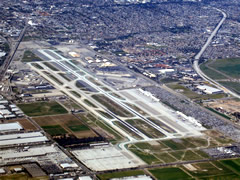 ONTARIO, CA – It’s a question that has been asked over and over again: What would the Ontario International Airport Authority do if it had control of Los Angeles/Ontario International Airport?
ONTARIO, CA – It’s a question that has been asked over and over again: What would the Ontario International Airport Authority do if it had control of Los Angeles/Ontario International Airport?
The multi-jurisdictional alliance at its Monday morning meeting approved a formal document that details how it would address its four main goals – reducing airline costs, developing airport-related businesses, expanding air service and providing customer-friendly facilities and services.
The five-page document provides the most details about how the authority would operate the airport if it gains control of the facility from the city of Los Angeles.
“It’s a high-altitude plan for success,” said commissioner Jim Bowman, who also sits on a subcommittee in charge of drafting the document.
ONT’s passenger traffic has continued to decline in recent years accelerating an effort by local officials to acquire the facility from Los
Angeles.
Ontario City Manager Chris Hughes, the authority’s executive director, is negotiating with Los Angeles officials over the transfer of ONT to the authority.
ONT is owned and operated by the Los Angeles World Airports, a city department that also oversees operations at Los Angeles International and Van Nuys airports.
“Presenting publicly an outline for a business plan lends credibility to what our turnaround strategy is and the direction we are going with it,” said Alan Wapner, president of the authority.
The executive summary outlined the authority’s mission statement to strive, operate and grow ONT to become one of the most “competitive, efficient, innovative and customer-friendly passenger, cargo and business airports” in the United States.
The plan also aims to ensure the medium-hub facility remains an economic asset for the Inland Empire.
Nick Johnson, a consultant with Oak Park-based Johnson Aviation, detailed some of the challenges facing ONT and the airline industry at Monday’s meeting.
ONT is often not competitive, especially against regional airports, when airlines look to add new service at low-cost airports, Johnson said
Reducing these overall costs will be the authority’s goal from the start.
“Until they can fix job one, you can’t really begin to take any steps forward,” Johnson said. “It all begins and ends with a low-cost airport.”
The authority’s most immediate step would be to reduce the 15 percent administrative overhead fee as well as solve the issue of overstaffing.
Another goal involves developing a master plan for ONT and its surrounding property.
Because of the vast, empty property surrounding the airport, there could be an opportunity to bring in new development after control is handed over, Johnson said.
“It’s that set of infrastructure that is already built here that make this is a prime cargo location that has never fully been captured,” said Johnson, referring to the freeway and rail connections near the airport.
Future development at ONT also would benefit by local distribution facilities and the city’s foresight to properly plan the land-use around the property.
There is already enough transportation in place to support any new projects or developments, Johnson said.
“I see a community that is really focused on doing smart development with developers to work together,” he said.
“You have to create good environment for investment to happen.”
It’s that mindset that also goes hand in hand with another authority goal – to provide customer-friendly facilities and services.
The plan also details expanding air service and add more flights and destinations at a reasonable cost.
“The executive summary encapsulates the major stakeholders groups for the airlines to the business economic community to the consumer,” said Lucy Dunn, a commission member and Orange County Business Council CEO and president.
“When you have those three major components overlapping each other you know success can come because you are taking care of everyone.”
CalPilots Editor’s Note: It is clear that the issue here is money. Ontario has invested heavily in it’s Commercial Airport, and feels it is not getting the attention it should, and therefore they want to manage it. Seems reasonable.
Why is it that our state general aviation airports don’t get as much attention? Probably because they don’t have the large obvious monetary income value of a large commercial airport. The thing is, GA airports do bring money into a community. The airport sponsor would have to do some work to verify this though, hence they remain in the norm and assume that GA Airports don’t pay their own way.
